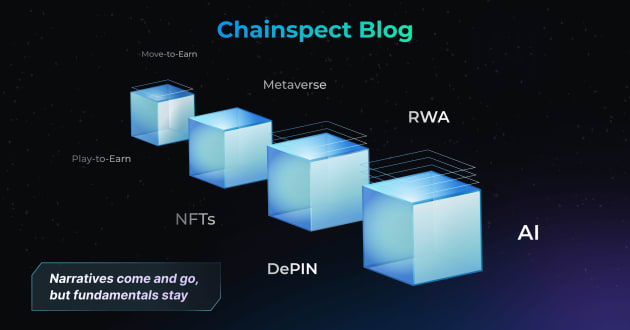Remember when the Metaverse was the future? Not Zuck’s corporate Matrix, but the real one—on-chain, owned by users. Celebs bought digital land, tokens pumped like it was DeFi Summer all over again… and then? Poof. Now, AI is all the rage, or DePIN, or maybe DePAI, if you like to mix and match.
The point is — crypto moves fast. We’ve seen the DeFi Summer, move-to-earn, play-to-earn, and it was always the next big thing until it wasn’t. Some trends flew by fast, others lingered for a bit, but in the end, the crypto crowd would move on to whatever made heads spin next… And miss out on something very crucial.
The problem: Hype vs. reality
Yes, crypto loves its narratives. The problem is, though, that more often than not, those are built on speculation. Maybe, it sounds fun, maybe, it sounds expensive; one way or another, if it seems like a degen’s ticket out of the trenches, degens will do what degens do best: Ape in, and whatever happens, happens.
If the amount of research involved in this process doesn’t sound convincing to you, well… You are very much on point. Your run-of-the-mill hype aficionados (and even some institutions that we politely won’t be pointing fingers at) often just look for a bandwagon to hop on. They chase trends, narratives, and buzz without giving much thought to how much a chain, protocol, dApp, or whatever else is actually being used.
What this results in is the all-too-familiar crypto story: Buying into the hype, sustaining the hype (you did buy in, why would you FUD your own bags now?), getting everyone’s expectations too high… And then, that nasty thing called reality kicks in. It doesn’t even have to be a rug, that’s not what we mean here. When people expect too much, any result is not enough.
Even DYOR won’t always save you—just ask Meta’s boardroom how that pivot worked out, and they’ve probably done more homework than an average degen. Chartering the future is no easy work, and the more ambitious and far-fetched any given promise is, the more difficult it is to estimate its feasibility (assuming it can at all be taken at face value).
And there it is, the never-ending cycle of inflated expectations, hype bubbles, and eventual crashes. So here’s a little alpha: Don’t get lost in the noise — dig in deeper.
It’s all in the fundamentals
If you let go off the noise for a second, you will see that blockchain adoption has been making steady progress—which is more than many past trends can say for themselves. And the metrics that show long-term success are a lot less ethereal than abstract promises of plenty.
At the end of the day, it all simply comes down to usage. A successful crypto project, especially when it comes to layer-1s, is one that consistently draws users and activity. If you see that consistent activity over a respectable period of time, not a short spike and then dead air, you are likely looking at a project that’s here to stay.
This consistent activity can reveal itself through a variety of metrics. Here are just some to consider:
Real-time TPS (transactions per second)
Active addresses
Total value locked (TVL)
Developer activity
Some projects fade, but those that stay in the trenches and offer real utility stick around and thrive.
Why Tracking Real-Time TPS Matters
TPS and other on-chain metrics tell you what’s actually happening—the reality behind the buzz. They give you a clear picture of usage and activity while also enabling you to estimate prospective winners from the standpoint of what they’ve delivered so far.
The thing is, more often than not, the next big thing, whatever it is, takes scale. Onboarding one billion users through play-to-earn? Well, imagine how many transactions each of those users will be making, and how many of them stick around if these transactions take hours to process. Building DePINs of millions of devices? That’s obviously a massive amount of transactions as well. Having millions of AI agents trade RWAs onchain? You guessed it, that’s a bottleneck in the making too.
To accommodate any prospective use case, industry, or asset class, a chain has to scale well—and perform under pressure. This can be measured through objective metrics based on onchain data, first and foremost its TPS stats: real-time, max recorded, and max theoretical.
We did an entire blog with a detailed breakdown of all of these, but just in case, here is a quick reminder:
Real-time TPS is how many transactions (per second) a chain is handling right now.
Max recorded TPS is how it performed under peak demand.
Max theoretical TPS is how many transactions it can churn out per second under perfect conditions.
When considered together, these fundamental metrics give you an overview of a blockchain’s ability to keep spinning during high workload, which is a key precondition for adoption. By following the on-chain activity dynamics and keeping track of chains’ performance, you can stay ahead of the game and see who is well-positioned to grow and deliver.
Stay ahead of the game with Chainspect
As exciting as any new narrative might be, never forget about the fundamentals—in the long run, they will get you further than pure hype. With Chainspect, Web3’s top tool for blockchain performance research, you can bring your fundamental analysis to the next level and stay ahead of the market. Want to see which chains actually deliver? Skip the noise—track real performance in real-time with Chainspect.
